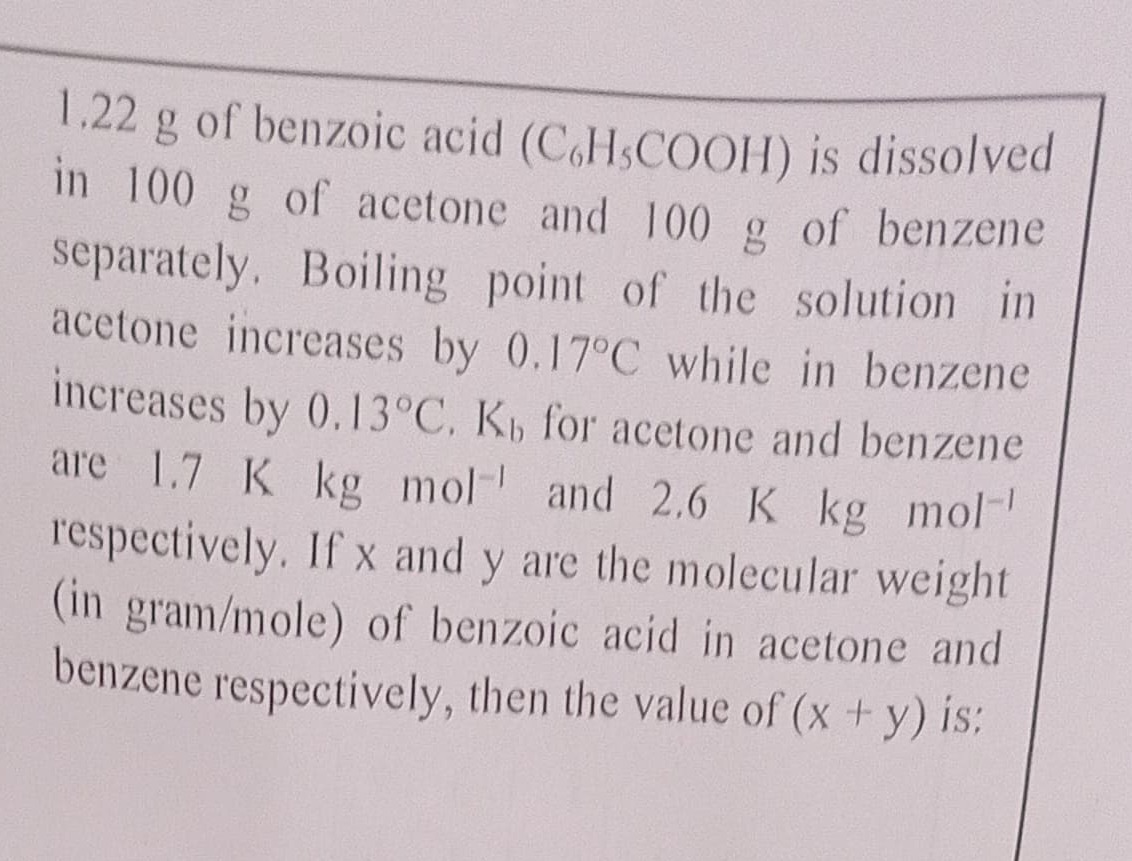Question
Question: 1.22 g of benzoic acid (C$_{6}$H$_{5}$COOH) is dissolved in 100 g of acetone and 100 g of benzene se...
1.22 g of benzoic acid (C6H5COOH) is dissolved in 100 g of acetone and 100 g of benzene separately. Boiling point of the solution in acetone increases by 0.17°C while in benzene increases by 0.13°C. Kb for acetone and benzene are 1.7 K kg mol−1 and 2.6 K kg mol−1 respectively. If x and y are the molecular weight (in gram/mole) of benzoic acid in acetone and benzene respectively, then the value of (x + y) is:

366
Solution
The boiling point elevation (ΔTb) is a colligative property given by the formula:
ΔTb=Kb⋅mwhere Kb is the ebullioscopic constant and m is the molality of the solution.
Molality (m) is defined as:
m=mass of solvent (kg)moles of solute=w1/1000w2/M2Here, w2 is the mass of the solute, M2 is the molecular weight of the solute, and w1 is the mass of the solvent in grams.
Substituting the expression for molality into the boiling point elevation formula:
ΔTb=Kb⋅M2⋅w1(kg)w2We can rearrange this formula to solve for the observed molecular weight (M2):
M2=ΔTb⋅w1(kg)Kb⋅w2Given:
Mass of benzoic acid (w2) = 1.22 g
Mass of solvent (w1) = 100 g = 0.1 kg
1. Benzoic acid in Acetone:
- Boiling point elevation (ΔTb) = 0.17 °C
- Kb for acetone = 1.7 K kg mol−1
- Let 'x' be the molecular weight of benzoic acid in acetone.
Using the formula for M2:
x=0.17 K⋅0.1 kg1.7 K kg mol−1⋅1.22 g x=0.0172.074 x=122 g/molThe theoretical molecular weight of benzoic acid (C6H5COOH) is 7×12.01+6×1.008+2×16.00≈122.12 g/mol. Since the observed molecular weight is close to the theoretical value, benzoic acid exists as a monomer in acetone.
2. Benzoic acid in Benzene:
- Boiling point elevation (ΔTb) = 0.13 °C
- Kb for benzene = 2.6 K kg mol−1
- Let 'y' be the molecular weight of benzoic acid in benzene.
Using the formula for M2:
y=0.13 K⋅0.1 kg2.6 K kg mol−1⋅1.22 g y=0.0133.172 y=244 g/molThe observed molecular weight 'y' (244 g/mol) is approximately twice the theoretical molecular weight of benzoic acid (122 g/mol). This indicates that benzoic acid undergoes dimerization in benzene due to hydrogen bonding, forming a cyclic dimer.
3. Value of (x + y):
x+y=122+244=366